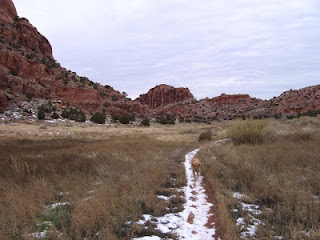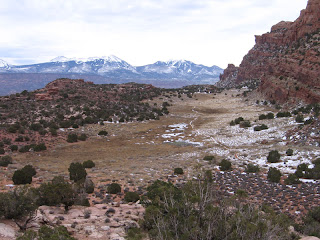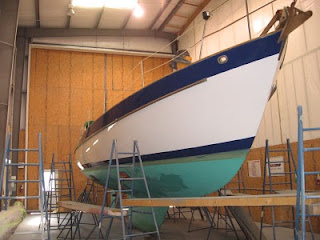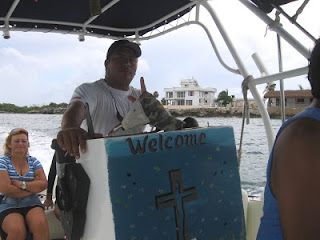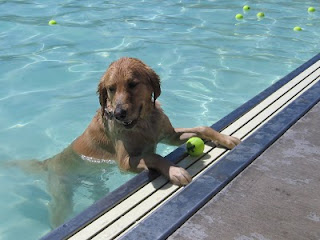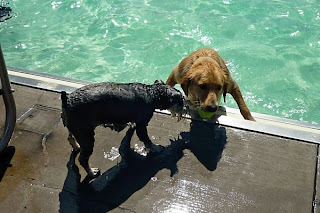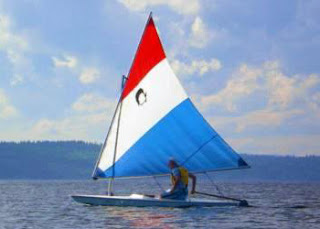 Part 16
Part 16 marked the end of the Boat Quest series. As of May 15, I am the proud owner of Little Walk, a 1980 Valiant 40. As one dream is made real, a new one is enabled. I now have the means to sail anywhere in the world. Where to go?
Well, the first stop is the boatyard, to make the necessary repairs and upgrades that will ensure safe travels. During our Central America sailing trip a few months ago, I spoke with John Kretschmer about my plans to sail the boat--if I ended up buying it--from Baltimore to Savannah, where my parents have a vacation home, to get the necessary work done. He had a better idea: his sister Liz and brother-in-law Trevor are partners in a marina and boatyard in Solomons Island, Maryland. Their people are experts at the kind of work I needed, and as an FOJ (Friend of John), they would take extra special care of me and my boat. What more could I ask for? John said he would contact them to make the necessary introductions.
That just left figuring out how to get the boat from the Riviera Beach area, southeast of Baltimore, to Solomons Island, a distance of about seventy-five miles. To be safe, I didn't want to sail alone, especially on an unfamiliar boat. I needed to find someone to go with me. The kicker was that the boat needed to be moved from its current location at Tony's dock within a week and a half, so I needed someone who would be available on short notice. Kevin Harrison, from our Odyssey sailing trip, came immediately to mind. He lives in Elizabethtown, Pennsylvania, only a hundred miles from where the boat was docked, and he would have just completed teaching the spring term at McDaniel College. I emailed him an invitation, and he emailed me back right away with an acceptance. We spoke over the phone a couple of days later to work out a strategy for meeting at the boat, driving two cars down to Solomons, and leaving one there for the return trip. Kevin agreed to bring his toolkit, just in case, and I agreed to provision for the short trip and cover his expenses.
Kevin and I met at the boat on Sunday morning, May 23. We hauled our stuff aboard, and I gave him a quick tour. He liked what he saw, except for all the bird poop on the deck. We took the time to wash down the deck so it would be clean and dry when we returned, and then we got into our respective cars for the drive down to Solomons.

A couple of hours later, we met up again at the Spring Cove Marina's parking lot. We wandered around to get a feel for the place and its facilities and then walked into the office and asked to see Trevor. He came down from his office, and we spent a few minutes getting acquainted through our mutual connection to John Kretschmer. I ended the conversation by telling him we were headed back up to Baltimore to sail my boat down to the marina and that we would be back by early the next afternoon. He wished us well, and we left in my rental car to drive back up to the boat.
Tony was home when we returned, asleep in the hammock that overlooks his dock. He roused as we were preparing to depart and came down to talk with us. It's a good thing that he did, or we might have left the boat's meager fenders and dock lines behind. He assured us that they went with the boat. We thanked him, fired up the engine, and shoved off. There was only one problem: no water was coming out with the exhaust. I tried frantically to remember what Ray had said about where the water coolant seacock was located, but I had no idea. There had just been too many details during the orientation. I also forgot the way out of Rock Creek, because we found ourselves going up a dead-end tributary. It was time to call Ray. Fortunately, he answered--maybe he was expecting my call. He calmly told me to turn off the engine before it overheated and then directed me to look under the seat in the aft cabin for the seacock. I sent Kevin below to find it so I wouldn't lose the call, and he reported that as soon as he turned it, he could see water flowing through the associated filter's clear top. We fired up the engine again and looked over the side to see water coming out with the exhaust. The engine's temperature fell to about 110 degrees and stayed there. One disaster was averted. But we still didn't know where we were going. I still had Ray on the phone, so I tried to explain the landmarks around us. He didn't recognize anything but told me to follow the starboard-side shore until I could see the White Rocks Marina, which I should recognize from our sea trial sail. From there, I should know where to go. I thanked him and told him I would call later to let him know how we were doing.

Kevin and I could have cheered when we reached the open water of Chesapeake Bay, but we noticed that the water was extremely shallow--no more than fifteen feet deep--even at White Rocks, a small formation of bird poop-covered rocks (thus the name), about a half-mile offshore, and we were concerned about running aground. After we passed the rocks, we rounded up into the wind, put up the sails, and bore off to the south for Annapolis, our destination for the day, all the while keeping an eye on the depth meter.
There was enough wind to just sail, and we were in no great hurry, so we cut the engine and trimmed the sails. The GPS showed us at six-plus knots, with occasional bursts over seven, not bad for the blustery, unsettled weather conditions. Kevin and I took turns at the helm since neither the windvane or electronic autopilots were working. Before long, we had passed under the William Preston Lane Jr. Memorial Bridge, which was our cue to turn west toward Annapolis. We started the engine and doused the sails as we passed the Naval Academy and sighted the public docks, where we picked up a mooring for the night. We settled up with the harbormaster who came out to greet us and then hailed a water taxi using the VHF radio. The taxi driver suggested the Middleton Tavern for dinner, so we gave it a try. Good steaks and atmosphere.
We were up by 5:00 the next morning to get an early start on the remaining sixty miles. I tried to boil water for instant coffee, but I couldn't figure out how to get the stove lit--guess I should have covered that in the orientation with Ray. We made due with juice and muffins as we motored out of Annapolis harbor and headed south for Solomons. Spring Cove Marina normally stops hauling boats out at about 2:00, so we motorsailed all the way to make good time in the hopes of meeting that deadline.

We arrived at a little after 1:00 and were directed to tie up at the end of a T-shaped dock. Kevin wasn't feeling well and went to find a bathroom. I went off to find Trevor, who informed me that the haul-out bay was busy and that they wouldn't be able to haul my boat out for a day or two. Oh, well. At least we were there safely, even if we hadn't needed to leave Annapolis quite so early. Trevor introduced me to his wife Liz, who is John Kretschmer's sister, and we chatted for a few minutes, mostly about John and his escapades. The family resemblance was easy to see. Liz excused herself, and Trevor and I walked over to the haul-out bay, where I met Trevor's brother Alan, who was stepping a mast. We walked up to the shop and met Don, the boatyard manager, who was painting a mast. Don would be the person coordinating the work on Little Walk, so we set up a meeting for the next morning. To give him an advance idea of what was involved, I told him I would leave a copy of the boat survey on his desk.
Kevin and I hauled our stuff off the boat, readjusted the dock lines, and drove to a nearby hotel. After showers, we went off in search of a cold beer, which we found at the famous Tiki Bar, and then dinner at a waterfront restaurant. It had been a long day. After dinner, we returned to the hotel and called it an early night.
Kevin and I had compiled a short list of items the boat needed, so after breakfast the next morning, we went to the local West Marine store to see if we could find it all. We did. Those places are amazing, like boating toy stores. We returned to the boat to drop off the new goodies before my meeting with Don. When he showed up, Kevin wandered off to look at boats and said he would meet me at his car when I was ready to go. Don and I walked around on the deck, looking at the mast and rigging, and then went below to look at the chainplates and engine. He was pretty matter-of-fact about things, saying that a thirty-year-old boat should be expected to need the types of repairs we were considering. I mentioned that I wanted to get the ratty cushions reupholstered. He said I should pitch them, that the foam was old and disintegrating, and get new ones, plus a real mattress for the aft berth. He also suggested replacing the manual windlass with an electric one. I hadn't thought of any of these things, but he was right. All it would take is money, of course. Don said I should probably expect to pay almost what I had paid for the boat to get it into top condition, more if it needed a new engine. I nodded knowingly, but I was thinking, "Whoa! That's a lot more than I was expecting!" The first order of business was to pull the mast. Don thought they would have that done within a couple of weeks. We agreed to stay in touch about the work as it progressed, and I went off to find Kevin for the drive back to Baltimore and the flight home.
Thank you for all your help, Kevin!
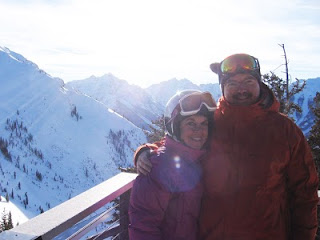 For the holidays this year, Nan and I are house and dog sitting for our friends, the Vaughns, in Aspen. They are in Costa Rica with family and we are looking after things back home. Their dog Hannah and our dog Scout get along well, romping in the snow together and competing for our affection, so the Vaughns are happy to have us stay here instead of having to board her.
For the holidays this year, Nan and I are house and dog sitting for our friends, the Vaughns, in Aspen. They are in Costa Rica with family and we are looking after things back home. Their dog Hannah and our dog Scout get along well, romping in the snow together and competing for our affection, so the Vaughns are happy to have us stay here instead of having to board her. Later, Jon and I caught the shuttle bus back to Aspen Highlands and met Nan, who had earlier taken Scout and Hannah for a cross-country ski up Maroon Creek Road, for an end-of-day top-to-bottom ski run. I wanted to get a good ski photo of Nan and me, and Jon suggested the new Ski Patrol hut at the top of the mountain for its amazing views. The sun was low in the sky and directly behind us, but Jon's photo turned out nicely, with the sun's flare coming from between Pyramid Peak and the Maroon Bells in the distant background.
Later, Jon and I caught the shuttle bus back to Aspen Highlands and met Nan, who had earlier taken Scout and Hannah for a cross-country ski up Maroon Creek Road, for an end-of-day top-to-bottom ski run. I wanted to get a good ski photo of Nan and me, and Jon suggested the new Ski Patrol hut at the top of the mountain for its amazing views. The sun was low in the sky and directly behind us, but Jon's photo turned out nicely, with the sun's flare coming from between Pyramid Peak and the Maroon Bells in the distant background.
 Raising Charlie: The Lessons of a Perfect Dog
Raising Charlie: The Lessons of a Perfect Dog





